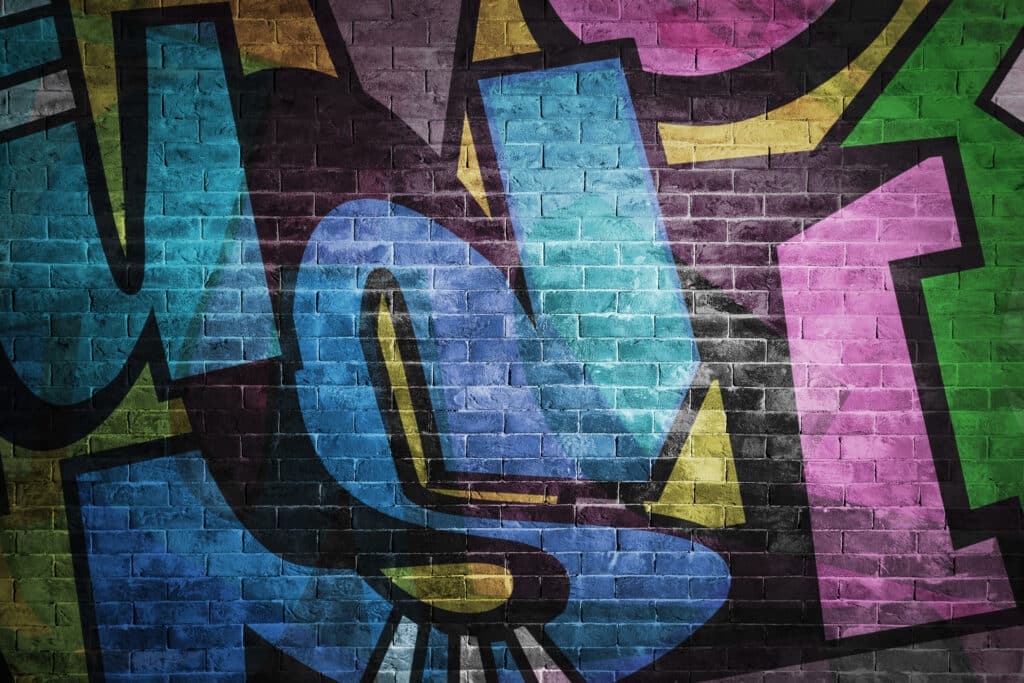Graffiti refers to any drawings or writing applied to public surfaces, usually with spray paint. Commonly the result of vandalism, graffiti is unsightly and significantly hurts curb appeal. Even worse, the application of spray paint can seriously damage some surfaces like brick and stucco. Removing graffiti has its own set of challenges, but it has to be done (and done well) if you want to restore your property to its original glory.

How to Get Rid of Graffiti
Removing graffiti requires an impressive amount of finesse. An inexperienced hand will leave bits of paint or a “shadow” of where the graffiti used to be. Without experience to temper pressure settings, DIY attempts to clean away graffiti can also damage the material underneath, leaving scoring or causing it to chip. Entrusting the task to the professionals is the best way to make sure the graffiti is removed completely and satisfactorily.
Removing graffiti is usually a two-part process, applying the right blend of chemicals to wear down the spray paint and then rinsing the surface clean with a good pressure or power wash. A professional pressure washing team will know which solutions and methods are best for your specific situation.

The Correct Chemicals
While sometimes it is possible to use pressure washing alone to remove graffiti—especially if the paint hasn’t had long to sink into the surface—usually treating the stain with chemicals is the most important step. The right cocktail of chemicals is effective at removing graffiti for one of two reasons: either it will wear down the paint’s color or, even better, it will destroy the glue within the paint.
If you don’t want to damage your painted surface further, it is vital that you use the right chemical solution to clean away graffiti. This often includes trisodium phosphate (TSP), but the mixture should reflect the kind of surface being cleaned and how long the paint has been there. How the cleaners are applied is also important since you don’t want to drive the chemicals into the surface.
It is common to apply the chemical cleaning solution with a pressure washer on a low setting: 80 psi is a safe choice. This will coat the surface of the spray paint with the chemicals without forcing the cleaners into the material’s pores. Once the mixture has had a little time to work on the graffiti, it can be rinsed off with a higher pressure.
Removing Graffiti with Pressure Washing
A pressure washer will be your best friend when removing graffiti. In some cases, it is all that is needed to strip away the unwanted art. In others, pressure washers can be used to apply chemicals and to rinse them and the paint away. Sometimes, however, you need a little more power to clean away graffiti. Sometimes this can be achieved by using a turbo nozzle, which focuses a pressure washer’s spray even more. In other instances, you will need to add heat.
Heat is the biggest difference between pressure washing and power washing. Power washers incorporate a heating element, allowing them to utilize rinsing power 100-times that of cold water. Hot water gives home- and business owners 100% success in removing graffiti 98% of the time. We recommend using hot water at low pressure to layer the chemicals onto the spray paint’s surface, then rinsing at higher pressures to completely erase the stain.

Is It Possible to Power Wash Graffiti Off of Brick?
Getting graffiti off of brick can be troublesome for a number of reasons. Because brick is so obviously porous, the wrong pressure can chip pieces of it off or embed the spray paint further into the material. Use gentler chemicals and pressure settings to apply them. Consult with your local pressure washing company for recommendations or let them manage the job for best results.
Will Pressure Washing Remove Spray Paint from Metal Surfaces?
If you discover graffiti on your vehicle, it can be tempting to reach for the pressure washer. We recommend you pause and consider professional assistance. Metal, especially when it is used to shape vehicles, doesn’t always hold up well under a stream of pressurized water. While a pressure washer can usually strip away spray paint from metal, the results aren’t always improved.
The success of pressure washing metal depends very much on the type of nozzle used, how the paint was applied, and how long it has been there. Interestingly enough, unlike other surfaces, paint added more recently can be more difficult to remove from metal surfaces. Get a professional opinion before moving forward.
[author_info]
